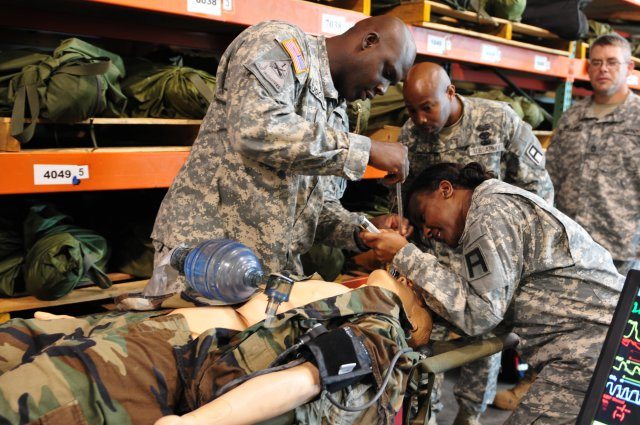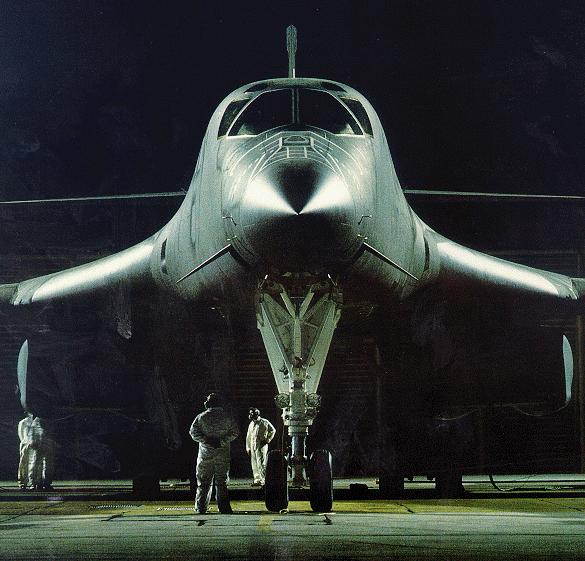With blood loss being the leading cause of preventable death on the battlefield, First Army Division East is incorporating more realistic, up-to-date training to prepare the nation’s deploying Soldiers for treating injuries on the battlefield. The ultimate goal: more lives saved.
Recently, 11 combat medics from First Army Division East underwent four days of in-depth train-the-trainer-type training on the Laerdal® SimMan patient simulator at the Regional Training Site-Medical located at Fort Gordon, Ga. Upon returning to their mobilization training sites, these medics will then use their knowledge and experience to train medics prior to their deployments.
Unlike active duty Soldiers who work and train daily in their chosen career field, Reserve component service members only have approximately 39 days a year to achieve the same level of proficiency prior to mobilization, which makes simulated training a beneficial tool.
“This simulated training is good. I think it’s very relevant, especially given the training tasks and missions we handle,” said Sgt. 1st Class Matthew Furnace, a combat medic with the 158th Infantry Brigade, Camp Shelby, Miss.
The SimMan simulator, a mobile, realistic state-of-the-art simulated medical patient mannequin, can be programmed with simulated “real world” medical scenarios for students training in all aspects of medicine. It is equipped with realistic breathing, vocal, cardiac, lung, pulse, and sounds that can be transmitted from the simulator through its computer software.
“Automated mannequins provide us the most realistic medical training available,” said Lt. Col. George Kyle, First Army Division East surgeon.
“With them, we can replicate the body’s physical and physiological reaction to injuries on the battlefield,” said Kyle.
GETTING FAMILIAR
Throughout the course the Soldiers reviewed and practiced various aspects of operating the SimMan.
“The first thing we did was set the simulator up,” said Staff Sgt. Jeffrey Mullins, a special skills trainer and medic with the 72nd Field Artillery Brigade. We were able to actually see the vital signs on the screen once the mannequin was tethered to the computer system.”
The Soldiers practiced proper care and maintenance of the mannequin and computer system, how to up-load scenarios and how to read the historical log the computer produces whenever the SimMan is touched.
“Having that log and being able to see what has been done to the mannequin is part of what makes the training so relevant,” said Furnace.
Furnace went on to explain that the real-time data that service members receive forces them to pay more attention and to be more aware of their actions while operating the equipment.
“It gives the Soldier an opportunity to get that real-time feedback on how they are actually doing. Are they positioning things correctly, are they checking the pulse right. I think it makes it very relevant,” explained Furnace.
IMPLEMENTING SimMan
Each of First Army Division East’s training brigades has two patient simulators similar to the SimMan. This course, coupled with the trainer mentors first-hand experience, will allow the brigade medical staffs to more readily train medical service personnel.
“Being able to operate and have total control over the simulation has been a real good experience,” said Furnace. “I think that it is going to be very helpful in providing a more relevant and a more proactive Soldier when it comes to medical treatment.”
Furnace went on to say that human-like simulators are being implemented across the board due to their realistic training potential.
“This sort of training is very realistic, especially how in-depth you can get with the simulation. The more we learn about it and the intricacies of the system, I think it gives us an opportunity to provide some real realistic training for Soldiers,” said Mullins.
Previously the Army has used Common Task Training, or CTT, which is developed annually to promote hands-on training and to evaluate critical battlefield survival skills.
“This is a great addition to the old CTT training with your battle buddy,” said Furnace. “I don’t think it can ever replace putting your hands on a person. At the end of the day that’s about as real as it gets. Being able to incorporate the practical hands on training with the simulations is going to be a really great addition to the training.”
With constant changes on the battlefield and with the military’s mission continually evolving First Army Division East will continue to incorporate new technology and training practices to ensure the nations’ service members are well prepares for what lies ahead of them.
“Simulated training is critical to obtaining maximum realism in training, This training is directly improving our Soldiers and medics ability to save lives,” said Kyle.
First Army Division East’s primary mission is to train, mobilize, and deploy Reserve Component Soldiers into contingency operations worldwide.











